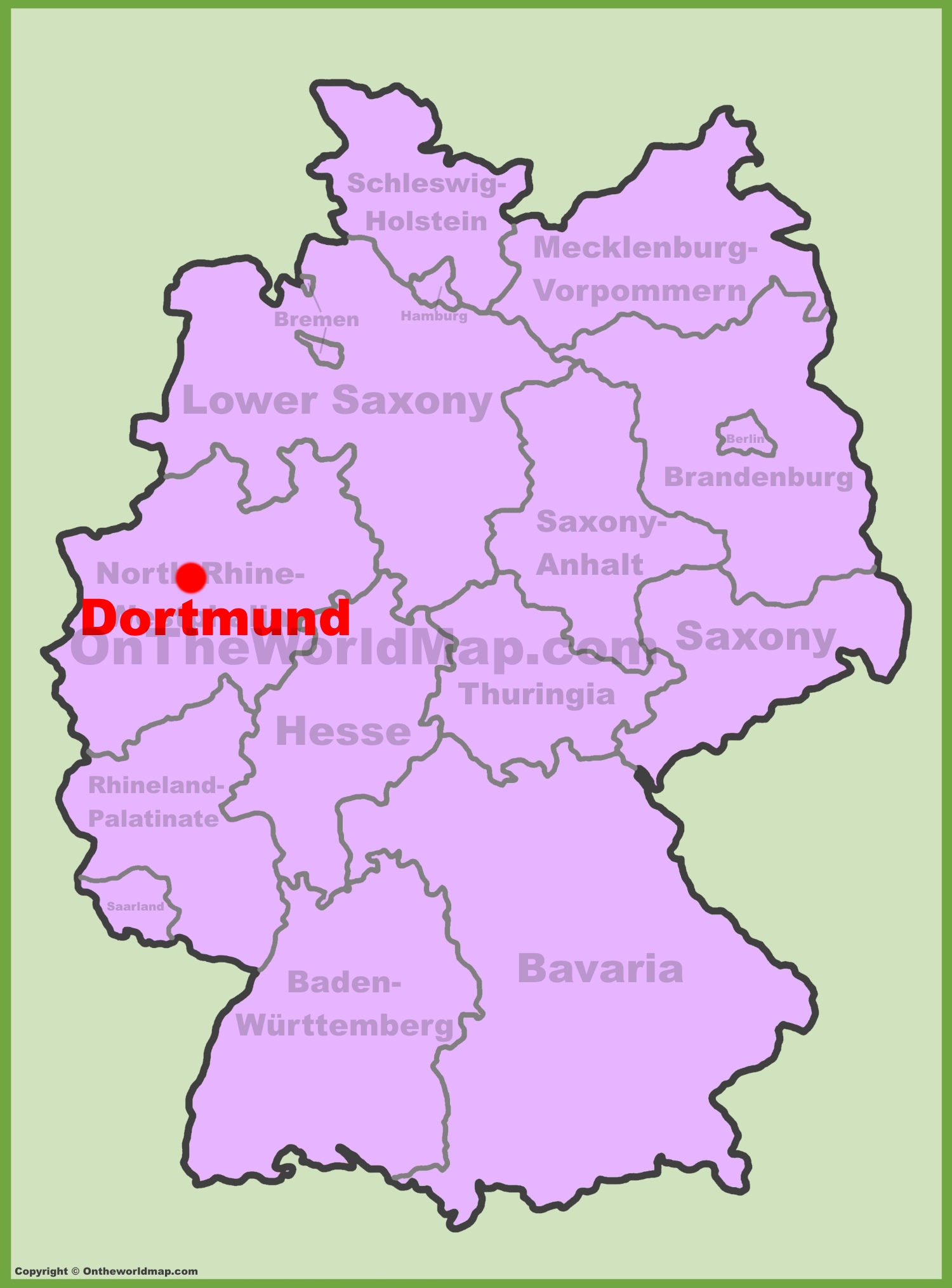Map of Dortmund- Germany

Dortmund is an independent city in North Rhine-Westphalia, Germany. It is in the middle part of the state and is considered to be the administrative, commercial and cultural centre of the eastern Ruhr area. Its population of 581,612 (2015) makes it the 8th largest city in Germany. Moreover, Dortmund is the largest city by area and population in the Ruhr Area, an urban area with some 5.1 million (2011) inhabitants which is the largest urban agglomeration in Germany.
Founded around 882, Dortmund became an Imperial Free City. Throughout the 13th to 14th centuries, it was the “chief city” of the Rhine, Westphalia, the Netherlands Circle of the Hanseatic League. After the Thirty Years’ War the city was destroyed and decreased in significance until the onset of industrialization. The city then became one of Germany’s most important coal, steel and beer centres until the 1970s. The region has adapted since the collapse of its century long steel and coal industries and shifted to high technology biomedical technology, micro systems technology and also services. In 2009, Dortmund was classified as a Node city in the Innovation Cities Index published by 2thinknow and is the most sustainable city in Germany.
Dortmund is home to many cultural and educational institutions, including the Technical University of Dortmund and Dortmund University of Applied Sciences and Arts, International School of Management and other educational, cultural and administrative facilities with over 49,000 students, many museums, such as Museum Ostwall, Museum für Kunst und Kulturgeschichte, German Football Museum, as well as theatres and music venues like the Konzerthaus or the opera house of Dortmund. The city is known as Westphalia’s “green metropolis”. Nearly half the municipal territory consists of waterways, woodland, agriculture and green spaces with spacious parks such as Westfalenpark and Rombergpark. This stands in a stark contrast with nearly a hundred years of extensive coal mining and steel milling within the city limits.
Dortmund is home to Ballspielverein Borussia 09 e.V. Dortmund, commonly known as Borussia Dortmund, a successful club in German football.
Population: 581,612 (2015)
Language: German
Currency
Euro (EUR)

Geography
Location
Dortmund is an independent city located in the east of the Ruhr area, one of the largest urban areas in Europe (see also: megalopolis), comprising eleven independent cities and four districts with some 5.3 million inhabitants. The city limits of Dortmund itself are 87 km (54 mi) long and border twelve cities, two independent and ten kreisangehörig (i.e., belonging to a district), with a total population of approximately 2.4 million. The following cities border Dortmund (clockwise starting from north-east): Bochum, Castrop-Rauxel, Waltrop, Lünen, Kamen, Unna, Holzwickede, Schwerte, Hagen, Herdecke and Witten. Historically speaking, Dortmund is a part of Westphalia which is situated in the Bundesland North Rhine-Westphalia. Moreover, Dortmund is part of Westphalian Lowland and adjoins with the Ardey Hills in the south of the city to the Sauerland.
The lowest point can be found in the northern borough of Brechten at 48,9m, the highest point in the borough of Syburg at 254,3 m.
Boroughs
Dortmund comprises 62 neighbourhoods which in turn are grouped into twelve boroughs (called Stadtbezirke), often named after the most important neighbourhood. Three boroughs cover the area of the inner city (Innenstadt-West, Innenstadt-Nord, Innenstadt-Ost) and the remaining nine boroughs make up the surrounding area (Eving, Scharnhorst, Brackel, Aplerbeck, Hörde, Hombruch, Lütgendortmund, Huckarde, Mengede). Each Stadtbezirk is assigned a Roman numeral and has a local governing body of nineteen members with limited authority. Most of the boroughs were originally independent municipalities but were gradually annexed from 1905 to 1975. This long-lasting process of annexation has led to a strong identification of the population with “their” boroughs or districts and to a rare peculiarity: The borough of Hörde, located in the south of Dortmund and independent until 1928, has its own coat of arms.
Climate
Dortmund is situated in the temperate climate zone. Winters are comparatively mild, summers rather cool. The average annual temperature lies at approximately 9 to 10 °C (48 to 50 °F), the total average annual amount of precipitation lies at approximately 800 mm (31 in). Precipitation evenly falls throughout the year; steady rain (with some snow), prevails in the wintertime, isolated showers dominate the summer season. Dortmund features characteristics of densely populated areas as for example the occurrence of urban heat islands is typical.
Religion
Dortmund was historically a Protestant-dominated city. However, during the 19th century an increasing number of Catholics moved there from East Prussia, Silesia and Poland. As of 2014 the largest Christian denominations were Protestantism (29.9%) and Roman Catholicism (27.4% of the population).Furthermore, in Dortmund the Greek Orthodox Church, the Serbian Orthodox Church and the Macedonian Orthodox Church are represented. The Church of holy apostle (gre. I.N. Αγίων Αποστόλων Ντόρτμουντ – I.N. Agíon Apostólon Dortmund) is one of the oldest in Germany. Also Dortmund is home of the New Apostolic Church in North Rhine-Westphalia with more than 84.944 community members.
The Jewish community has a history dating back to Medieval times and has always ranked among the largest in Westphalia. Dortmund is home to the National Association of Jewish Communities of Westfalen-Lippe. The synagogues operate there in City center, Hörde and Dorstfeld. Due to the growing immigration of people from Muslim countries beginning in the 1960s. Dortmund has a large Muslim community with more than 30 Mosques.
Transportation
Road transport
Dortmund also serves as a major European and German crossroads for the Autobahnsystem. The Ruhrschnellweg follows old Hanseatic trade routes to connect the city with the other metropolises of the Ruhr Area. It crosses the Dutch-German border as a continuation of the Dutch A67 and crosses the Rhine, leads through the Ruhr valley toward Bochum, becoming B 1 (Bundesstraße 1) at the Kreuz Dortmund West and eventually merging into the A 44 near Holzwickede. It has officially been named Ruhrschnellweg (Ruhr Fast Way), but locals usually call it Ruhrschleichweg (Ruhr Crawling Way) or “the Ruhr area’s longest parking lot”. According to Der Spiegel, it is the most congested motorway in Germany.
Connections to more distant parts of Germany are maintained by Autobahn routes A1 and A2, which traverse the north and east city limits and meet at the Kamener Kreuz interchange north-east of Dortmund. In combination with the Autobahn A45 to the west these form the Dortmund Beltway (Dortmunder Autobahnring).
Rail transport
As with most communes in the Ruhr area, local transport is carried out by a local, publicly owned company for transport within the city, the DB Regio subsidiary of Deutsche Bahn for regional transport and Deutsche Bahn itself for long-distance journeys. The local carrier, Dortmunder Stadtwerke (DSW21), is a member of the Verkehrsverbund Rhein-Ruhr (VRR) association of public transport companies in the Ruhr area, which provides a uniform fare structure in the whole region. Within the VRR region, tickets are valid on lines of all members as well as DB’s railway lines (except the high-speed InterCity and Intercity-Express networks) and can be bought at ticket machines and service centres of DSW21, all other members of VRR, and DB.
The central train station (Dortmund Hauptbahnhof) is the third largest long distance traffic junction in Germany. Dortmund has a railway service with Deutsche Bahn InterCity and ICE-trains stopping at Dortmund Hauptbahnhof (Dortmund Main Station). ICE and TGV Thalys high-speed trains link Dortmund with Amsterdam, Brussels (in 2h 30) and Paris (in 3h 50). There are frequent ICE trains to other German cities, including Frankfurt am Main, Berlin and other cities in the Rhein-Ruhr Region.
For public transportation, the city has an extensive Stadtbahn and bus system. The U-Bahn has eight lines (U41 to U49) serving Dortmund and the large suburb of Lünen in the north. The trains that run on the line are in fact lightrails as many lines travel along a track in the middle of the street instead of underground further from the city centre. The minimum service interval is 2.5 minutes, although the usual pattern is that each line runs at 5 to 10 minute intervals. In April 2008, the newly constructed east-west underground light rail line was opened, completing the underground service in the city centre and replacing the last trams on the surface.
A number of bus lines complete the Dortmund public transport system. Night buses replace U-Bahn and tram services between 1:30 am and 3:30 am. The central junction for the night bus service is Reinoldikirche in the city centre, where all night bus lines start and end.
The H-Bahn at Dortmund University of Technology is a hanging monorail built specifically to shuttle passengers between the university’s two campuses, which are now also flanked by research laboratories and other high-tech corporations and startups. A nearly identical monorail system transfers passengers at Düsseldorf Airport.
Air transport
Dortmund Airport is a medium-sized, but fast growing airport 13 km (8.1 mi) east of the city centre at the city limit to Holzwickede. The closest intercontinental airport is Düsseldorf International Airport.
Water transport
Dortmund Harbour (Hafen) is the largest canal harbour in Europe and the 11th fluvial harbour in Germany.












